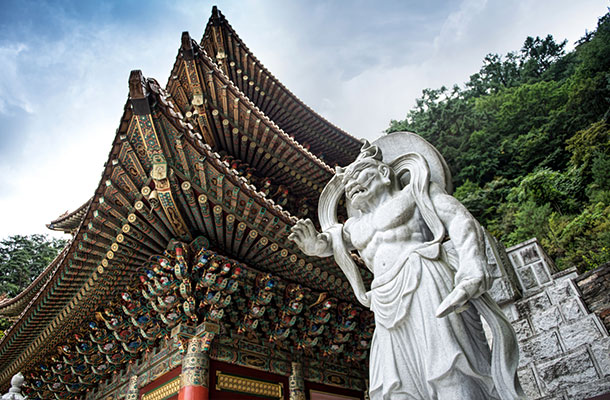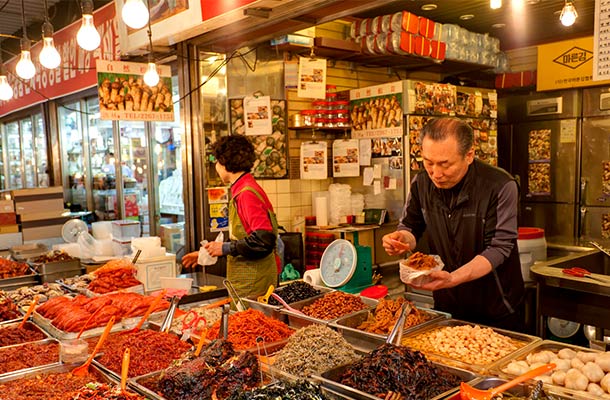5 Ways to Get Off the Beaten Path in South Korea
There’s so much more to South Korea than bustling cities, neon lights, and K-Pop music. Here's how to experience South Korea like a local.
 Photo © iStock/studiojh
Photo © iStock/studiojh
Since the Korean War, South Korea has remarkably built itself up to become a leading world-class country. It's a large exporter of cars and electronics, produces talented filmmakers and athletes, and serves as a major hub for travelers coming and going through Asia via Incheon International Airport, an airport that has topped the lists of best airports in the world numerous times.
Here’s are a few ways to get off the beaten path in South Korea.
- Hiking in South Korea
- Party With the Locals
- Eat Like a Local in South Korea
- Learn Taekwondo
- Guinsa Temple
Get Active and Go Hiking
One of Korea’s favourite past times is to go hiking. During the popular months in the spring and fall, Koreans hit the hiking trails on a weekly basis. Since the country is so mountainous your options are endless. There are over a dozen trails to choose from in Seoul alone! But to get the most out of your hiking experience, and to avoid a busy trail during the peak seasons, opt for a route outside of the city.
You don’t have to be a professional hiker to tackle these mountains. There are routes for all levels from beginners to advanced hikers. Just about all the routes can be completed in a day, some even within a few hours, so there’s no need to worry about a tent and cooking equipment. Wear some breathable clothing, strap on a pair of good, supportive shoes and don’t forget a bottle of water! And when you reach the summit and take in the surrounding scenery, you might even get lucky and be invited to join a nearby picnic with the locals.
Bukhansan National Park and Seoraksan National Park are just two of the many great spots to hit the hiking trails.
Party With the Locals
Itaewon and Hongdae are popular hot spots for tourists looking to experience nightlife in Seoul. But if you’re wanting to see where many of the Seoulites get their drinks and dance on, head over to Gangnam or the more upscale, Apgujeong.
Gangnam is chock full of restaurants, bars, noraebangs (karaoke rooms), cafes, and a large underground “boutique-esq” shopping centre. Makeshift street vendors set up shop at night along the main street selling everything from shoes to jewellery, DVDs to handbags.
If you want something a little more mellow and upscale, head to Apgujeong. Wine and sake bars, kitchy cafes, and western-inspired restaurants line the side streets. If nothing more, this area is great for people and fashion watching.
Eat More Than Just Korean BBQ and Kimchi
Korea’s most popular food is undoubtedly its BBQ. However, there’s more to Korean cuisine than grilled meat and kimchi. Korea boasts a wide variety of dishes drawing from their mountainous regions, rice fields, and coastal surroundings.
If you like spicy food be sure to try some of the following; gamjatang, a potato and pork spine soup with noodles, dalk galbi, a chicken, cabbage, and rice cake dish cooked in a large iron skillet, suntubu-jjigae, a tofu and vegetable stew served in a stone bowl topped with a raw egg, or for the bravest of all, galbijim, short ribs slow-cooked in a spicy broth that will have you feeling like you could breath fire!
But, if spicy food doesn’t sit well with you, there are still plenty of other options to whet your appetite. If you’re down by the southern coast you can’t go wrong with any of the seafood dishes, but a must on your culinary list should be jajangmyeon, a noodle dish topped with a black bean sauce served with vegetables and either meat or seafood. This dish is actually adopted from Korea’s Chinese neighbours.
During the rainy season, Koreans pack into restaurants serving pajeon, a thick pancake-like dish loaded with green onions, and seafood or meat if you desire. Be sure to opt for makgeolli or dong-dongju (a rice wine alcohol) to wash it all down.
To help cool you down in the summer months, have a bowl of mul-naengmyeon, a cold, buckwheat noodle soup with a tangy broth, and vinegar or mustard added to your liking. It’s guaranteed to make the hot-humid temperatures more bearable.
Learn Taekwondo
Taekwondo is a form of martial arts that focuses on punching and kicking combat techniques. It’s Korea’s national sport, and somewhat of a right of passage for Korean kids.
If you’re going to be in Korea for a period of time you should pop in to a local taekwondo school and take some classes. Most schools will be very open and welcoming to visitors, allowing them a chance to share a part of their Korean culture with you. Some of them may not even charge you for a class but instead ask you to purchase your own uniform (a do-bok) which will run you at most $30-40.
It’s an excellent form of exercise, helping you improve flexibility, stamina, and balance. And you’ll be able to come home with quite the souvenir and stories to share.
Guinsa Temple
Buddhism was first introduced to Korea around the fourth century A.D, and slowly influenced the culture and way of life of the people. Since then, numerous temples have been built throughout the country with about 30% of the population practicing this religion today. The most famous, and one of the oldest temples in Korea, is Bulguksa, located in the old capital city of Gyeongju. But there is another, less frequented but equally if not more impressive temple, that is definitely worth a visit.
Guinsa Temple is located in the small city of Danyang in Chungcheongbukdo province. Built within a valley surrounded by mountains, it is an incredible collection of 34 buildings, including a 5-story Dharma Law Hall, the largest in scale in Korea. The temple can accommodate up to 10,000 people and even offers temple stays for visitors who want to experience life in a temple.
It’s a bit of a hike working your way up through the various buildings, past the fermenting clay pots, and up to the Great Teacher Hall at the top of the valley. But with each turn and set of stairs completed, you’ll be left in awe of the beauty and serenity of the grounds.
Related articles
Simple and flexible travel insurance
You can buy at home or while traveling, and claim online from anywhere in the world. With 150+ adventure activities covered and 24/7 emergency assistance.
Get a quote

No Comments